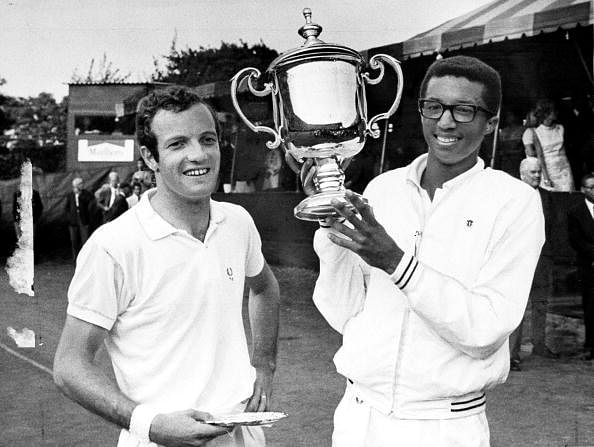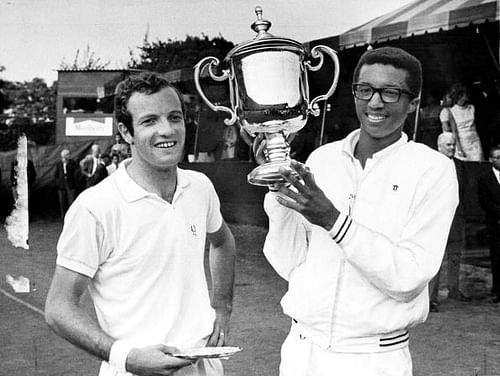
US Open classics: The first US 'Open' final, 1968

Arthur Ashe holds trophy after defeating Tom Okker (left)
In a few hours from now, the 2013 edition of the US Open will begin. The big stories of the fortnight will revolve around the likes of Rafael Nadal and Serena Williams and their attempts at attaining individual glory. The New York lights will shine, the crowds will cheer, the players will roar, the atmosphere will be electric.
All of this will be a far cry from 46 years ago when the US Open, as we know it, actually began, and an African-American man was crowned champion in a historically significant final, which also turned out to be a classic.
It was the year 1968, and the war between the amateurs and the professionals was finally turning in favour of the latter. The US Championships was all set to go ‘Open’ and allow tennis professionals to compete along with the amateurs.
The build-up to the tournament was filled with anticipation. People who looked at the big picture could see that this was likely to be the trigger for some drastic changes in the way tennis would be played, and people who were more interested in the days’ events were just excited at the high quality of tennis to be expected with all the professionals now in the fray.
True to expectations, the top four seeds for the first ever US Open were highly fancied professionals, all from the Australian golden generation – Laver, Roche, Rosewall and Newcombe.
But in an ironic turn of events, none of the professionals, for whom this tournament was intended to be a big break, would end up justifying their high rating. The stars all fell one by one, and the final ended up being played by two amateurs.
Tom Okker, known as the ‘Flying Dutchman’, belonged to the unique breed of the ‘registered player’ – an amateur who was allowed to collect money from certain tournaments. Facing him in the final was the African-American Arthur Ashe. Ashe, 25 years old at the time, was the top American player and billed as a future star, but still an amateur at the time.
He served as a lieutenant in the US Army, and he maintained his amateur status in order to be eligible to play in the Davis Cup. Thus, the final of the first US ‘Open’ was contested by two players, neither of whom were fully-fledged tennis ‘professionals’.
The US Open of 1968 was starkly different from the Flushing Meadows spectacle of today. The tournament was a grass-court affair, played on the worn-out greens of Forest Hills. It would continue to be so till 1975, when the playing surface was changed to clay for three years, before the venue was moved in 1978 to Flushing Meadows and the hard courts of today.
The concept of a tie-breaker was yet to be introduced in tennis Majors, and this resulted in an extended, pulsating first set in the final which ended 14-12 in favour of Ashe. This remained the longest set of tennis to be played in a Major final until 2009, when Federer and Roddick played their hearts out at Wimbledon.
Ashe and Okker used their serve-and-volley games to great effect, with there being plenty of momentum swings right through the match. Each time Ashe seemed to draw away, Okker came back to level the scores. After splitting the first two sets, Ashe finally broke through, thanks to his superiority in power and a cool, unflappable temperament, which was to become his hallmark in the years to come.
Arthur Ashe became the champion of the first US ‘Open’ tennis major, with a final scoreline of 14-12, 5-7, 6-3, 3-6, 6-3. In a sign of the strange times in which the match was played, Ashe received no prize money for his win, apart from the $20 dollar per diem earned as an amateur. Okker, on the other hand, walked away with a cheque of $14,000.
The event was a sign of changing times in the history of professional tennis, but it was also significant from other perspectives as well.
Arthur Ashe became the first African-American male to ever win a tennis Major, and was also the first African-American Grand Slam champion after Althea Gibson. With this win, he cemented his reputation as the best American tennis player, a legacy he would build on in the coming years.
Soon after, in 1970, Ashe turned professional, and went on to attain further tennis glory, culminating in a memorable 1975 Wimbledon victory over Jimmy Connors. His performances on the tennis court gave him the platform to launch into social and political activism, for causes which would make him a personality known far beyond tennis and sporting boundaries.
The first US Open of 1968, expectedly, had its share of downs as well. Apart from the below-par showing of the professional players, the introduction of commerce in the form of cigarette advertisements into the tournament left people grumbling. There were rumours of draws being fixed by managers of the professionals in order to avoid them meeting each other in the early rounds. The tournament was run by three different organizing bodies, and its management was criticized.
But in the long run, the tournament was seen as the first tentative peek by America into a bold, new dawn for tennis. It was one of the series of events that laid the foundations for the highly successful and competitive tennis circuit that we see today.
So over the next fortnight, when we see a Djokovic and a Murray in the heat of battle on centre court, it might be worthwhile to think back to the man after whom the court is named, Arthur Ashe, and of his own tennis battle with Tom Okker in 1968, which set the tone for years to come.